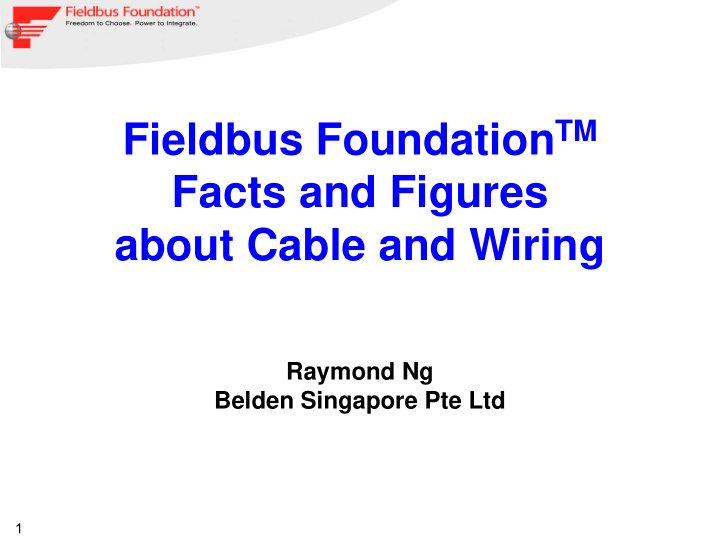



Fieldbus Foundation TM Facts and Figures about Cable and Wiring Raymond Ng Belden Singapore Pte Ltd 1
Agenda • Foundation Fieldbus Cable Standard – IEC 61158-2 – FF-844 • Cable Selection – Standard instrumentation cable –vs- FF cable – AWG size, Shielding, Jacketing, Armor types • Cable Installation & Termination • Q & A 2
IEC 61158-2 Type “A” Cable Specification • Impedance: 100 Ohms • Attenuation: < 3 dB/km • Capacitance Unbalance: CcS 4nF/km max. CcS Drain wire Jacket • Conductor DC Shield Resistance: 24 Ohms/km max. • Maximum Propagation Insulation Conductor Delay Change: 1.7 μ s/km • Wire Size: .8mm sq. Ccc (18 AWG) nominally • Shield Coverage > 90% 3
FF-844 – Cable Test Specification • Builds on IEC Requirements to further qualify cables • Addition to IEC requirements – Expands on shielding requirements – Specifies 10 to 22 pair twists/meter Lay Length – Jacket Resistance – Required and optional cable ratings – Recommended connector characteristics • Cable registration is in process 4
Instrumentation –vs- FF Cable FF Cable Instrumentation Cable • Polyolefin Insulation • PVC or XLPE Insulation – Electronic grade insulation • 100 Ohm Impedance • 35-65 Ohm Impedance • 66% Velocity of • 55 to 60% Velocity of Propagation Propagation • Designed with tolerances • Designed to meet general necessary to meet FF minimum instrumentation specifications cable requirements 5
Instrumentation –vs- FF Cable • FF cable has lower Capacitance • FF cable is designed to a specific impedance to reduce signal reflections and maximize network length FF cables are tested during production to meet • specific requirements: – Capacitance Unbalance – Impedance – Conductor D.C. resistance 6
Cable Selection • First consult with local authority having Jurisdiction to ensure regulatory compliance • Selection Guide – Conductor Size – Shielding – Armor – Jackets 7
Cable Selection – Conductor Size • Most common design is one pair 18 AWG • Larger AWG (16, 14) provide: – Improved pull strength – Electrical benefits, such as: Less Greater Reduced Voltage Current Resistance Drop Capacity Longer More Field Distance Instruments 8
Cable Selection – Shielding • Most common design: foil shield only – ~ 35 dB of Shield effectiveness – Most effective at high frequencies (>10 MHz) – Drain wire for easy termination • Combination shields – Foil in addition to braid – Shield effectiveness of ~ 80 dB – Effective from 60 Hz to GHz 9
Cable Selection – Armoring • Interlock – Steel – Aluminum • SWA (Steel Wire Armor) • Protective Metal Tapes: – Smooth or Corrugated (Steel, Copper, Aluminum) 10
Cable Selection – Armoring • Why use Armor? – Rodent protection – Physical integrity – Direct burial – Reduces cost of conduit – Hazardous Locations 11
Cable Selection – Jacketing • PVC – most common jacketing material • CPE – good chemical and abrasion resistance • LSZH – low smoke zero halogen applications • HDPE – direct burial applications • FEP – high or low temperature applications (-70 to 200C) 12
Cable Installation • Follow manufacturer’s recommendations – Bending radii: generally 10 to 12x cable diameter – Maximum pulling tension – Installation temperature – Pulling lubricant selection 13
Cable Termination • Ground shield at one end only – The near or “host” end – Use provided drain wire or “pigtail” the braid – Grounding both ends results in ground loops – Required to prevent noise ingress, which could distort the signal • Shields should be trimmed back flush with jacket – Isolate shield using heat shrink tubing or tape – This keeps the shield from being inadvertently shorted to the (+) or (-) wires or grounding at the device end 14
Post Installation Verification • Follow FF Engineering Guide AG-181 – Procedure for installing and commissioning fieldbus segments – Use DMM for Resistance & Capacitance measurements – Use Fieldbus Handheld tester to verify installation and operation 15
Common Installation Issues • Cable shield shorted to (+) or (-) wires • Cable shield grounded at both ends, increasing noise susceptibility • Routing of cables in parallel with AC power lines – Minimum of 6” separation per IEEE 518 – Minimize parallel runs – Cross power lines perpendicularly, when possible 16
Summary • FF-844 created to clarify cable requirements & register products • FF cable requirements are much more stringent than Instrumentation cabling requirements • Select cable that is compatible with application • Consult manufacturer for installation & termination recommendations • Follow AG-181 guidelines for testing FF segments 17
www.fieldbus.org 18
Recommend
More recommend